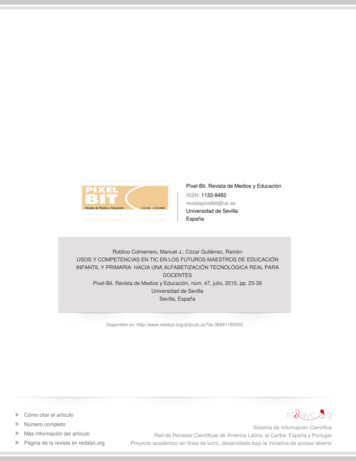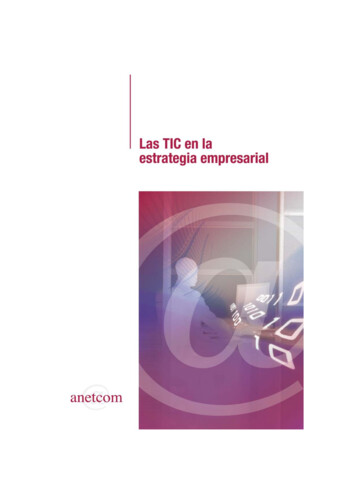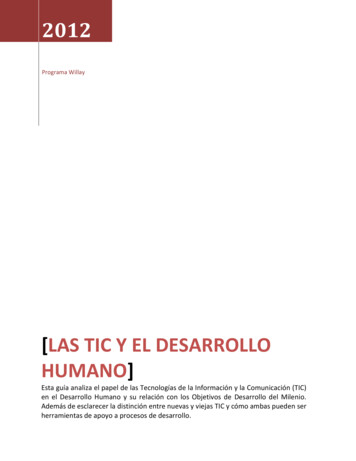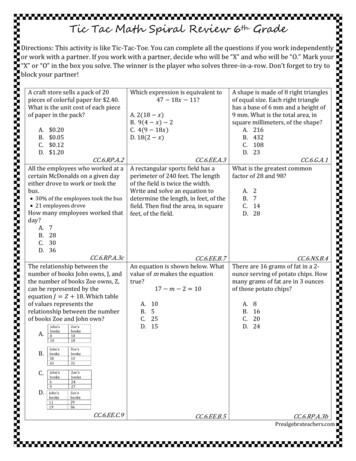
Transcription
ONEParticipant’s HandbookLESSON ONEA WORTHY IDEALSetting Goals“I believe in goals. It is never a bad thing to havea dream. If there is something you really wantto do, just do it. Whatever your goal.”“Everyone needs something to aim for. You can callit a challenge or you can call it a goal. It is whatmakes us human. It was challenges that took usfrom being cavemen to reaching for the stars.”Richard Branson7
ONEParticipant’s Handbook‘Thinking IntoCharacter’, you are going to develop an awarenessthat deciding what you want and getting what you wantare two completely different matters. As you begin theprocess of deciding what you want, how you are goingto get there is not relevant. Just know that the process forachieving your goal will be clearly explained. The conceptswhich you are learning in this particular lesson can effectivelybe applied to your education, your personal growth and toyour professional development.Remember Stephen Hawking’squote in Lesson One.there is always something youcan do and succeed at. It mattersthat you don’t just give up.”This is where the belief in yourselfcomes into play.Before you begin looking at the ABCs of goal setting, take a close look at your own belief system.There are belief barriers we all face when we set out to try to accomplish something beyond our levelof belief. Our minds will create many and seemingly valid reasons why something cannot be done.give up. Alternatively when you truly believe something can be done, your mind will create the ideasthat will help get you there and you will accomplish what you set out to do.The solution to achieving our goals sits with our belief. Therefore we must ask and challenge theanswers to these questions:1. Do I have good, sound reasons for my beliefs?2. Where do my beliefs come from?8
Participant’s Handbook3. Would changing my beliefs improve my life?4. How do I change my beliefs?As you attempt to answer some of these questions, many of your old views will fall to pieces.why you think as you think. Such practice is like conducting a mental housecleaning.The practiceof clear thinking tends to clarify the mind, tones up the faculties, sharpens the perceptions and givesone a stronger and better grasp of the basic essentials for a larger and richer life.Clear and exact thinking is a very great necessity. It is in fact a sure means to advancementon the material as well as the spiritual planes.A line of distinction, however, should be drawn between surface thought, that is, ordinary,trivial and commonplace thinking, and real thought, which is associated with the understandingof Truth.The latter is deep thinking, which arouses dormant powers, quickens the perceptions,and leads to the enlargement of the understanding.The former is but a passing phase of mental activity while the latter governs the life of man.The shallow, surface thought that we give to the ordinary duties and small things of daily life,is not the thought that reforms our character, develops our mind, or changes our belief andour destiny. It is the positive, deep, and penetrating thought that comes from profound andstrong conviction born of a higher perception and a clearer realisation of the Truth.The surface idea is not the real thought.The inner convictions which control one’s aims,desires, and motives, constitute the real thought of the individual and wholly determinethe course of the person’s life and personal destiny.”Raymond Holliwell9
Participant’s HandbookOur beliefs are based on our evaluation of something. Frequently whenwe re-evaluate a situation, our belief about that situation will change.Check your beliefs with respect to what you think you can accomplishin your personal, educational or professional life.2. KEY HIGHLIGHTSA goal is something you are pursuing,something whichyou’re really going to accomplish Ifsomething,you’re going to needyou have never done before.goal is designed to help you Agrow;it causes you to drawsomething from yourself thatyou didn’t even know was there. to be inspired by going aftersomething you really want; it’sgoing to have to come from inside.A goals are doing something Typeyou already know how to do. TypeB goals are what you think you cando. Type C goals are your wants.What you really want. Type C goalscome from your dreams and areoriginated through the effectiveuse of your imagination.If you know how to reach yourgoal, the goal is not going todo for you what goals aredesigned to do.1GOALSCBA10NOTES
Participant’s HandbookNOTES2Am I able?THEORYTHECREATIVEPROCESSDREAMSYou have to build the dream. Youtake the dream and moveit from a dream to a theory.must believe you are able and beYouwillingto do what is required inorder to turn the theory into a goal.not let outside conditions orDocircumstancesdictate howyou will live. Refuse to let anything that is goingon outside of you stop you.FACTAs you get emotionally involved in thegoal, you are going to involveyour emotions and the expressionof that emotional involvement isgoing to change your behaviour.As your behaviour changes, theresults start to change and yourtheory turns into a fact.without a goal are lost. PeopleThey have no direction. You’ve gotto wake up in the morning and getvery excited; “I’m working towardsmy goal!”.11
Participant’s Handbook3. WORKSHEETSImagine that you are getting ready to go to an exclusive networking event where you are going to bemeeting a number of very important people who can help you with your goals. These are people whoyou want to create a good impression with. It goes without saying, you would not go to this event withoutpaying attention to your physical appearance and even mentally reviewing the mindset you’d want. Thedetails of preparing yourself are important. The same is true with the exercises that have been laid out foryou in each lesson. Some of the early exercises in each lesson may not seem important. However, theyare crucial as you are building on them. And as you are taking your valuable time to study the ‘ThinkingInto Character’ programme, you should give the programme all you can, paying attention to every detail.1. If someone were to stop and ask you, “What is your goal?”— how would you respond? Do you havegoals? Are they written down or on your phone?2.what you really want. What do you really want? What is it you would like very much to be, door have, even though you may feel it is, for one reason or another, somewhat beyond your reachat the present time?Repeat the exercise you did earlier and allow yourself to relax and let your imagination wander.Dream. Create a shopping list of your wants. Include personal wants, educational wants andprofessional wants.As you are dreaming and visualising, do not give one moment of mental energy to how thisgoal is going to be accomplished. Do not concern yourself with where the resources, thetime, the support you may require, is going to come from.Attempting to think of how will either limit or destroy the dream. Just think of WHAT you want.12
Participant’s HandbookPersonal Wants“People with goals succeedbecause they know what theywant. It is as simple as that.”Earl Nightingale13
Participant’s HandbookEducational Wants“If you can imagine it, you canachieve it. If you can dream it,you can become it.”William Arthur Ward14
Participant’s HandbookProfessional Wants“Whatever your goal is, you willnever succeed unless you let goRichard Branson15
Participant’s HandbookFrom each of these lists of wants, select one that you want more than anything. It is essential thatyou choose something special, something you personally feel very drawn to and is important to you.You must want it—you must really want it, with your heart and soul. It is also important that thewants you choose are in harmony. They must not pull you in opposite directions.PERSONAL WANTEDUCATIONAL WANT16
Participant’s HandbookPROFESSIONAL WANT17
Participant’s HandbookIt is very important that you give all of your mental energy to building the image of the goal that you desire.Begin to think about these wants as an image in your mind. Write about these wants existing in yourlife in the present tense. See yourself in possession of whatever it is you want.I am so happy and grateful now that my Personal Want has materialised:(Describe your wants in detail and in the present tense.)18
Participant’s HandbookI am so happy and grateful now that my Educational Want has materialised:(Describe your wants in detail and in the present tense.)19
Participant’s Handbook(Describe your wants in detail and in the present tense.)20
Participant’s HandbookNOTESYou have enormous untapped creative potential. Everything you see aroundyou was once an idea which was conceived in the imagination. All imagesthat originate in the imagination are referred to as dreams. The internet wasa dream at one time. So were smartphones, gaming, 3-D Printing and rocketsto Mars! To exercise your creative faculty (your imagination), you begin bybuilding a dream. You mentally begin to play with that dream until you startreasoning factor, another one of your intellectual faculties, and you start tobuild the idea more clearly. This is where the image turns into a theory inyour conscious mind.Now before the theory can become a goal, you must ask yourself two questions.“Am I able to do this?” When you take into considerationthat the only two sources of reference we have to go to, science and theology,with respect to human potential, both clearly indicate that your potential ises’.The second question is quite different. It is, “Am I willing to do whatever isrequired to cause the image in my mind to materialise in physical form inmy life?” When your answer to that question is ‘Yes’, your theory immediatelybecomes a goal, and when you turn your goal over to the universal subconsciousof energy, takes over and your goal begins to move into physical form, with andthrough you. It causes your behaviour to change and at the same time begins todraw to you all those things required for the materialisation of your image. Beforelong, your theory becomes fact. Therein covers the three stages of creation,Dream, Theory and Fact. This is how everything has been accomplished.THEORYAm I able?DREAMSTHECREATIVEPROCESSFACT21
Participant’s HandbookNow write or type your personal, educational and professional goals on your Goal card andcapture it on your smartphone. You should be able to articulate your goals in concise sentences.Look at your goals every morning, as often as you can throughout the day, and every night. Soonyour goal will become a reality.How do you feel after setting your personal, educational and professional goals?In the space provided, write 6 action steps you can take right now to move towards these goalsiiiiiiivvviPrioritise these steps in the order you will act on them.22
Participant’s HandbookNOTESCapture your goal in your smartphone either by photographing a hard copyor by typing it into your phone. Get emotionally involved in that idea all of thetime throughout your day. By thinking about the goals you have established foryourself every morning, many times during the day, and every night - you beginmoving toward it and bringing it towards you. You must be able to see yourselfon the screen in your mind, already in possession of the goal, and you mustseriously want it. Remember, the picture that you hold in your mind mostoften will eventually be expressed in physical form or circumstance.Exercise For Improved ResultsFind a quiet place where you can be alone. Lie down and make sure youare comfortable. Relax all your muscles and take some deep breaths. Letyour arms rest by your side, relax your legs and let your feet fall outwards.Close your eyes and relax your face and neck. Feel the tension and worriesof the day leave you. Now let your imagination take you away to your dreamsand wants which are held deep inside you. What is it you that you really want?Who is it you want to be? What is it that you want to achieve in life?When you feel clear and free, allow an image to form on the screen in yourmind that you already have achieved your goal. Be aware of how you feelachieved that which you set out to accomplish. When you feel this picture isclear, write a detailed description of the picture that you created in your mind.Each day as you study the ‘Thinking Into Character’ learning system,review this lesson and the Key Highlights as often as you can. As you reviewthis powerful information over and over, you will see something new in theinformation that was not there before and you will see something new inyourself that was not there before. You are a different person operatingfrom a different level of awareness.Complete the Worksheets Continue to build an image of your personal, educational and professionalgoals in your mind. Be as descriptive as possible. On a daily basis, callthese images to mind and spend time visualising your goals.Call these images to mind when you wake up in the morning, and lastthing before you sleep.Continue to view the video, study the notes from the video and listen tothe podcast. Do this over and over again. The key to success is repetition.23
Participant’s Handbook4. READING ARTICLEA Worthy Destination - Adapted from Earl NightingaleBy setting specific, attainable, worthwhile goals youautomatically place yourself in the top 5% of people- achievers. Freedom - personal liberty, is the mostprecious thing on earth. You are free to pursue yourdreams in one of the richest countries on earth.You have the opportunity to succeed. The choiceis yours. Goals reflect your choice of destination.Do you have a burning desire to succeed despiteall challenges? Do you know exactly what youwant? Do you think about it every day of your life?That vision will carry you over every obstacle.Your dream is invisible to all the world except you.Every worthwhile achievement is a dream cometrue. What the mind can conceive and believe itcan achieve! We become what we think about.If we want something enough we will get it. Wecan have everything we want. Most people donot know what they want. Do you?The system of goal setting will work for a new carand will work for anything else too. Set worthygoals. Don’t drift along as a wandering generality.Be meaningful and specific. Aspire higher! Don’ttake life for granted. Goal setting is the very basisof any success. Success is the progressiverealisation of a worthy goal. Without a goalthere can be no success.You are in charge of yourlife to the degree you takecharge of your thoughts.Success is not a destination, but a journey.Anyone who is on course toward a worthy goal issuccessful. Success does not lie in the achievementof a goal but in its pursuit. Success is a journey. Weare successful as long as we’re working towardssomething we want to bring about in our lives. Theroad is better than the end. Success is being on theroad toward something we want to bring about. Wemust have balanced lives with many goals but thenwe must work at only one at a time. Anyone workingtoward any worthwhile goal is as successful asanyone else. We are happiest when we are workingtowards goals we have established for ourselves.24Success is whatever we want it to be. Worthy ofus whether it be real or an ideal. Success is joyand satisfaction in serving others. One thing a goalmust do is fill us with positive emotion when wethink about it. The more intensely we feel about agoal the more progressively we will move towards it.We cannot simply drift into worthwhile destinations.The odds are too great.Success is not a destination, but ajourney. Anyone who is on coursetowards a worthy goal is successful.We must set our sail and adjust our course. Whatis your next port of call, your goal? Is it clear andconcise in your mind? Do you have it written down?We need reminding, reinforcing. Do not be vagueor general. For example, be specific about howmuch you will earn this year, save this year, andinvest for retirement this year.Happiness comes from direction, not arrival.It’s the trip that is enjoyable. Moving towards ourgoals is more satisfying than after they have beenaccomplished. Set new goals as soon as one isrealised. Never stop the process. We should alwaysbe looking forward to a new accomplishment.Do not just settle for ‘needs’, make goals of ‘wants’.Develop a wish list. You will become what you thinkabout. Don’t be circular and chaotic in your thinkingor your life will reflect that. Written reminders helpus to hit the bullseye time and time again. Controlyour thoughts. Decide what you will think andconcentrate upon. You are in charge of your lifeto the degree you take charge of your thoughts.Carlyle said, “A person without a purpose is likea ship without a rudder.” What is your purpose?Is your mind made up? Munger said, “There isno road to success but through a clear strongpurpose.” Decide upon your goal. Insist upon it.Look at your written goals often every day. Seeyourself as having already attained your goal.You are now and you most certainly will becomewhat you think about.
Participant’s Handbook5. ASSIGNMENTWrite your answers in the space provided below.1. Make out a want list — write down everything that you would like to see come about in your life.2. After you have completed your want list, number the items in their order of importance.3. Make item number one as your present primary goal, use the balance of the list for later reference.4. Write down your current goal on this commitment card, print it out, and carry it with you in yourwallet or purse.MY COMMITMENT TO MYSELFI, ,hereby commit to pursuing my goal of.SignatureDate5. How will the achievement of this goal improve your life?2525
Participant’s HandbookNOTES26
a dream at one time. So were smartphones, gaming, 3-D Printing and rockets to Mars! To exercise your creative faculty (your imagination), you begin by building a dream. You mentally begin to play with that dream until you start reasoning factor, another one of your intellectual faculties, and you start to build the idea more clearly.











